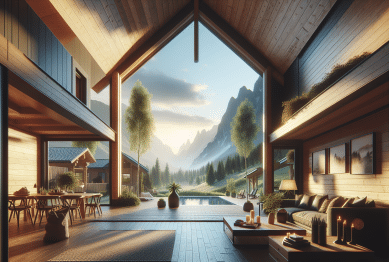Curious about the tiny home lifestyle? This guide shares the surprising perks, design ideas, and ways downsizing could transform your daily routine. Dive into space-saving hacks, organization methods, and real-life insights to help you consider if small-space living might be the sustainable change you seek.
Why Tiny Living Draws Big Attention
The appeal of tiny homes and smaller living spaces continues to grow in modern culture. For some, the attraction stems from a desire to simplify life and enjoy more freedom from clutter. More individuals and families are reevaluating traditional housing expectations. Instead, they explore how smaller, well-designed environments can support personal happiness and encourage a sustainable lifestyle. This tiny house movement captures people’s curiosity. It invites them to rethink what home truly means while seeking more meaningful experiences over excess possessions. Many discover that stepping away from big mortgages and constant upkeep creates more time for hobbies, travel, or community engagement. The ripple effects are often transformative—both physically and emotionally—making tiny living a significant lifestyle trend worthy of attention (Source: https://www.apartmenttherapy.com/why-you-should-consider-tiny-living-36623673).
Space-saving designs lie at the heart of the tiny home experience. Interior designers and homeowners get creative, utilizing vertical shelving, lofted beds, and convertible furniture to make every square foot count. Sliding doors, foldable tables, and clever storage solutions transform small areas into surprisingly functional living quarters. These innovations help people find comfort and convenience within compact dimensions. The challenge also becomes part of the fun—each adjustment can spark inspiration for new ways to live with less while still enjoying personal style. Many appreciate how minimalism within tiny living allows them to focus on essentials, reducing distractions and supporting a cleaner mindset. It’s about living with intention, carefully selecting what stays and what goes.
For others, the financial aspect of downsizing plays a pivotal role. Tiny homes often come with a lower price tag compared to traditional houses, potentially reducing housing costs and utility bills. These savings can open the door to new opportunities—like travel, starting a business venture, or investing in experiences over objects. The movement appeals to people at all stages of life—from college graduates seeking affordable starts to retirees looking for manageable spaces. Downsizing may sound daunting at first, but many report increased satisfaction and joy when living simply and mindfully. The popularity of small-space living is likely to keep rising, as it adapts to new technological advances and evolving lifestyle values.
Design Ideas That Make Small Spaces Shine
Small homes rely on creative design to maximize usability and comfort. Light colors on walls and ceilings can visually expand a room, making it feel brighter and more open. Mirrors add depth and reflect natural light, while strategically placed windows provide ventilation and connection to the outdoors. Combining these elements helps combat any sense of confinement, transforming compact quarters into airy sanctuaries. Homeowners frequently appreciate how thoughtful design choices enhance function without sacrificing aesthetics. Every piece has a purpose under the roof of a tiny home. Minimal clutter and smart layouts help rooms maintain a clean, calming ambiance that relieves stress and welcomes relaxation.
Multi-functional furniture remains a cornerstone of tiny living. Sofas become beds, desks transform into dining areas, and storage hides beneath stairs or inside benches. These items are more than clever—they make daily routines easier and adapt to changing needs. For those with hobbies or remote work, flexible spaces can quickly morph from an office to a creative studio or a cozy lounge. Custom solutions like pull-out pantries or wall-mounted bikes show that style and efficiency can go hand in hand. Many who embrace tiny living discover new passions for DIY projects, upcycling, and home customization—further fueling the creative community around compact dwelling spaces (Source: https://www.dwell.com/article/small-space-design-ideas-1c99ab70).
Outdoor extensions are another trick to increase usable space. A small balcony, rooftop garden, or patio can act as extra living room or entertaining zone. Portable grills, fold-out tables, and container gardens bring fresh air and versatility to tiny spaces. These outdoor solutions add value without requiring a square footage increase—something especially appreciated in urban settings, tiny apartments, or mobile dwellings. By blending indoor and outdoor living, tiny house enthusiasts create a greater sense of openness. Whether it’s a morning coffee spot or evening retreat, well-designed outdoor nooks improve quality of life and increase the joy found in small-scale settings.
The Minimalist Mindset—How Less Can Mean More
One of the most remarkable aspects of tiny living is the mindset shift it encourages. Minimalism, a guiding principle for many, isn’t about deprivation—it’s about intentionality. Residents prioritize meaningful objects, keeping only what truly supports their daily routine, hobbies, or sense of peace. This shift can feel liberating as it relieves homeowners from constant maintenance and consumer pressure. Instead of seeking happiness through accumulation, those living small invest their resources in connections and experiences. This philosophy resonates with the broader trend toward conscious living and environmental responsibility, as less consumption supports both well-being and the planet (Source: https://www.becomingminimalist.com/minimalist-living/).
Embracing minimalism leads to surprising benefits. Many report greater mental clarity, reduced stress, and improved focus. The routine process of evaluating possessions—deciding what stays and what goes—helps hone decision-making skills and clarity of values. Minimalist living can inspire intentional shopping, budget mindfulness, and a stronger sense of satisfaction with less. While downsizing often starts as a physical process, most find that inner transformation quickly follows. It becomes easier to let go of outdated habits, set goals, or adopt new daily rituals emphasizing calm and order.
Decluttering can also impact social dynamics. Smaller homes encourage deeper connection and quality time among family or roommates, while smaller-scale entertaining inspires creativity in hospitality. Portable lifestyles—even living in tiny homes on wheels—allow for new friendships and the ability to form communities with shared values. The minimalist movement is sometimes accused of being restrictive, but many tiny home enthusiasts argue that living with intention grants them unmatched freedom. In fact, the principles behind minimalism offer tools for anyone, regardless of whether they downsize. Simplifying priorities, routines, or schedules can yield similar rewards—no moving truck required.
Overcoming the Challenges of Downsizing
Transitioning to a small living space comes with unique hurdles. Letting go of cherished belongings, addressing sentimental attachments, or rethinking storage strategies requires patience and self-reflection. For some, the process is gradual, involving rounds of sorting and paring down. Professional organizers, support groups, and online communities offer encouragement and practical tips for managing this transition. Many find it helpful to focus on their ultimate goals—whether saving money, living sustainably, or finding personal peace. When clarity of purpose guides decision-making, downsizing feels purposeful rather than punishing (Source: https://www.theminimalists.com/downsizing/).
One challenge lies in learning to organize for maximum efficiency. Excess items quickly overwhelm a small home, so a dedicated system for tidying up is crucial. Creative use of vertical space, under-the-bed drawers, and multi-use furniture can make storage slick and easy. Adopting a regular decluttering routine keeps spaces functional and comfortable. Learning to tidy as part of everyday life becomes second nature to many who stick with it. Over time, the process becomes efficient and even enjoyable, especially when it brings visible rewards in livability and peace of mind.
Social and zoning considerations may also enter the mix. Some areas have minimum square footage rules or complex building codes that impact those interested in tiny living. Doing the research before committing to a major lifestyle change is essential. Likewise, tiny living may require honest conversations with partners or family to ensure everyone feels comfortable and heard. Listening to and accommodating the needs of loved ones fosters cooperation and can enhance the bond created through a shared, focused way of living. Most who embrace tiny living agree: the rewards often outweigh the initial discomfort and uncertainty.
How Tiny Living Supports a Sustainable Future
Environmental impact is another major motivation for tiny home enthusiasts. Smaller dwellings generally consume less energy—for heating, cooling, and lighting—than traditional homes. They can offer an ideal canvas for sustainable technologies such as solar panels, rainwater harvesting, and composting toilets. This emphasis on lower ecological footprint resonates with those passionate about conservation and responsible resource use. Some even opt for off-grid living, reinforcing self-reliance and eco-friendly practice (Source: https://www.epa.gov/greenliving/reducing-environmental-impact-tiny-homes).
Waste reduction is another benefit linked to tiny living. Less square footage naturally leads to less purchasing and accumulation. Residents focus on essentials or choose products with longer lifespans. Many tiny homeowners advocate for secondhand materials, upcycled décor, or locally sourced goods to reduce their environmental impact. Composting and recycling are regular parts of tiny home life, helping divert waste from landfills and supporting zero-waste aspirations. The ripple effect of these habits can inspire entire neighborhoods or extended circles to adopt greener habits and climate-friendly lifestyles.
Finally, tiny living often goes hand in hand with community engagement. Shared gardens, tool libraries, and collaborative events are common in neighborhoods where small dwellings cluster together. This collective approach amplifies resource sharing and emotional support. In contrast to the isolated, individualistic tendencies of urban high-rises or suburban sprawl, the tiny home movement prioritizes sustainable, connected living. Many report finding a heightened sense of belonging, reinforcing the idea that true comfort is found not in space or objects, but in relationships and mindful living (Source: https://www.tinyhomebuilders.com/blogs/tiny-living-and-community).
Real-Life Stories and Resources for Going Tiny
First-hand accounts offer invaluable insight for anyone pondering small-space living. From single professionals to multigenerational families, tiny home pioneers share tales of transformation, challenge, and triumph. Many point to the sense of liberation tiny homes bring—shedding unnecessary belongings, escaping debt, and gaining more time for creativity, wellness, or adventure. Some have documented their experiences to inspire others, offering practical advice and honest reflection on both the joys and realities of downsizing (Source: https://tinyhouseexpedition.com/tiny-living-real-stories/).
For those curious about the practical side, a wealth of resources exists to guide people through each step. Online forums, books, and video channels break down key topics: choosing a builder, arranging insurance, understanding zoning, and budgeting for a new home. Workshops and home tours can introduce potential tiny dwellers to firsthand experiences, addressing common concerns and misconceptions. Exploring these resources helps build confidence and clarify expectations. Many find the research process motivating, opening the door to new inspiration and fresh perspectives on what home can mean.
It’s wise to seek advice from multiple sources and to view the journey as a personal experiment. Tiny living is far from one-size-fits-all. It adapts to individuals’ needs, budgets, and dreams. Some may start by decluttering and organizing existing spaces before committing to architectural changes. Others jump in with both feet, building their own structure or joining established communities. Whatever the approach, stories and resources continue to empower people worldwide to embrace more intentional, fulfilling lives by going small (Source: https://www.curbed.com/tiny-homes).
References
1. Apartment Therapy. (n.d.). Why you should consider tiny living. Retrieved from https://www.apartmenttherapy.com/why-you-should-consider-tiny-living-36623673
2. Dwell. (n.d.). Small-space design ideas. Retrieved from https://www.dwell.com/article/small-space-design-ideas-1c99ab70
3. Becoming Minimalist. (n.d.). Minimalist living: How living with less can bring more meaning to your life. Retrieved from https://www.becomingminimalist.com/minimalist-living/
4. The Minimalists. (n.d.). Downsizing guide. Retrieved from https://www.theminimalists.com/downsizing/
5. EPA. (n.d.). Reducing environmental impact with tiny homes. Retrieved from https://www.epa.gov/greenliving/reducing-environmental-impact-tiny-homes
6. Tiny House Expedition. (n.d.). Tiny living real stories. Retrieved from https://tinyhouseexpedition.com/tiny-living-real-stories/









